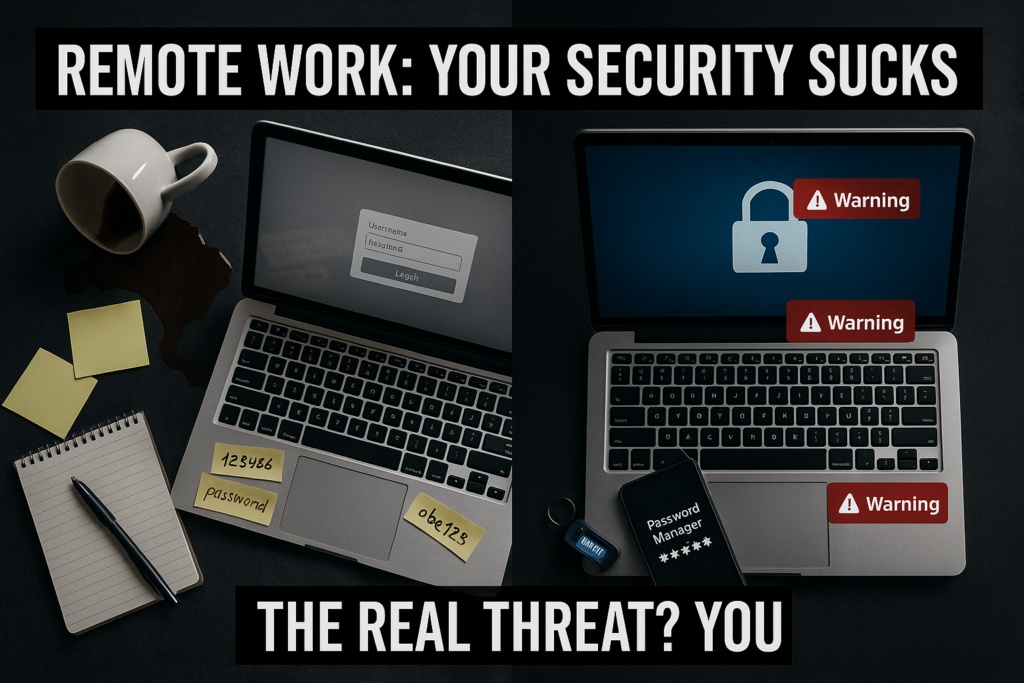
Most remote workers think cybersecurity is IT’s job. And technically, it is—until you click the wrong file, join the wrong Wi-Fi, or reuse the same password across five apps. Then it’s everyone’s problem.
Remote work didn’t just expand where we work. It widened the attack surface. And while companies scrambled to roll out VPNs and device policies, they overlooked one thing: basic user hygiene.
The Silent Risk in Every Home Office
You can install enterprise-grade firewalls and monitor endpoints all day, but none of it matters if someone stores passwords in a Notepad file or disables 2FA out of convenience.
Remote workers are often their own IT department. And that’s the problem. People plug into public Wi-Fi, skip software updates, or let family members use their work laptops. They don’t mean to compromise security—but it happens anyway.
Even now, years into the remote era, basic hygiene is missing:
- No password manager
- No phishing awareness
- No locked screens
- No device separation
The problem isn’t complexity. It’s laziness, convenience, and bad habits.
Surveillance Isn’t the Solution
Some companies responded with panic. They rolled out screen monitoring, auto-logout policies, location tracking—even webcam snapshots.
That doesn’t make people more secure. It makes them paranoid. And it pushes them to find workarounds.
Instead of investing in trust and training, many companies bet on control. But control doesn’t stop an employee from clicking a fake Slack login or using “password123” to meet a deadline.
Security isn’t about knowing where your people are. It’s about teaching them how to think.
Real Cybersecurity Starts With Behavior
Even if you’re “just” in data entry and never touch sensitive systems, that doesn’t mean you’re exempt. If you’re working with a company device or on a network that connects to anything valuable, you’re a vector. It’s still best practice to keep your data secure.
You don’t need a CISSP to practice common sense:
- Use a password manager. Stop memorizing garbage. Stop reusing passwords.
- Enable 2FA. Always. Even for your streaming accounts.
- Use a separate device for personal activity. Borrowing your kid’s tablet for a quick Slack reply? Don’t.
- Update your software. All of it. Not just Chrome.
Cybersecurity isn’t about tools. It’s about discipline. And discipline starts with mindset.
Internal Signal: It’s Not About the Tools
Our post on Essential Gadgets for Remote Work Success outlined the physical gear to stabilize remote productivity. But none of it matters if you’re logging in from an infected laptop or sharing devices with roommates.
Security is a system. And that system starts with you.
External Perspective: What Experts Actually Recommend
According to the Cybersecurity & Infrastructure Security Agency (CISA), the biggest gaps in remote security aren’t technical—they’re behavioral. Simple habits like verifying email senders, avoiding public Wi-Fi, and locking devices go further than most software.
CISA outlines several key practices in their Cybersecurity Best Practices page:
- Use strong, unique passwords (or a password manager)
- Enable multi-factor authentication (MFA) across all major accounts
- Keep all software—including browsers and OS—updated
- Stay alert for phishing or suspicious messages
They emphasize one key principle: security must be built into the workflow, not added on top of it.
Final Thought
You can blame IT. You can install the latest antivirus. But the biggest threat to your remote security isn’t hackers.
It’s shortcuts.
And you’re the one taking them.
